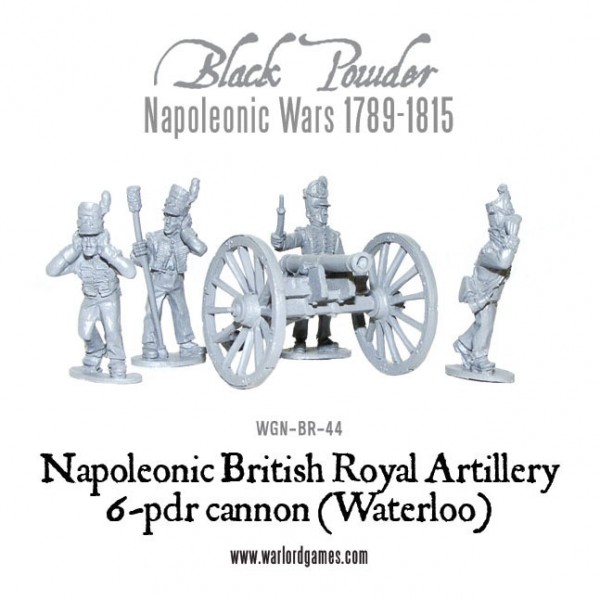
New: British Royal Artillery at Waterloo
Reinforce Wellington’s armies with these new arrivals from the Royal Artillery – a 6 pounder and mighty 9 pounder cannon, and a 5.5-inch Howitzer – dressed in uniforms suitable for participation during the Hundred Days campaign that culminated in the legendary Battle of Waterloo.
Napoleonic British Royal Artillery 6-pdr (Waterloo)
The six pounder was one of the lightest guns the British could bring to bear, firing a 6 pound cast iron shot. Light and easy to manoeuvre by horse, these guns could be relocated in a decent amount of time. Introduced in 1793 to give valuable heavy support to the cavalry, the 6 pounder was an improvement on the much smaller 3 pounder which was still in use at the time. With this cannon, heavier support could be brought in and still keep up with the cavalry units when on the march. The 6 pounder could achieve roughly 55 hits at 200 yards but this lessened when the targets were further away, only achieving six hits with roundshot at 600 yards.
Napoleonic British Royal Artillery 9-pdr (Waterloo)
The 6 pounder’s larger cousin, the 9 pounder, would be more commonly seen on a ship of the line than the battlefield. The cannon fired a heavy calibre shot at a greater range, whilst still being able to be manoeuvred relatively easily. Whilst heavier than its smaller cousin, it brought greater range and heavier firepower, making it useful not just against both infantry and cavalry but also of use in siege warfare. The 9 pounder had a range of around 800 yards if loaded with roundshot and about 500 yards if loaded with canister. However it was most effective at 350 yards, which was found to be the best range for causing maximum damage.
Napoleonic British Royal Artillery 5.5-inch Howitzer (Waterloo)
The 5.5 howitzer was used for siege warfare as well as on the battlefield. Unlike the mortars of the period, the howitzer was more manoeuvrable, but could still fire a projectile over a greater distance and could do so indirectly. The howitzer fired a high explosive shot, blowing apart almost anything the round hit. Alternatively it could also fire a flammable round (carcass) and rounds for illuminating the battlefield.
These new cannons are the perfect addition to our growing British Napoleonic range:
You might also like…
 Showcase: Waterloo British Infantry by Francesco Thau
Showcase: Waterloo British Infantry by Francesco Thau Showcase: Waterloo British Infantry by Francesco Thau – part 2
Showcase: Waterloo British Infantry by Francesco Thau – part 2 New: Napoleonic British Artillery
New: Napoleonic British Artillery New: Napoleonic Nassau Light Infantry firing
New: Napoleonic Nassau Light Infantry firing New: Napoleonic British Royal Horse Artillery 5.5-inch Howitzer
New: Napoleonic British Royal Horse Artillery 5.5-inch Howitzer Pre-Order: Napoleonic British special offers
Pre-Order: Napoleonic British special offers New: Napoleonic British Starter Army boxed set
New: Napoleonic British Starter Army boxed set New: Napoleonic Hanoverian Infantry plastic boxed set
New: Napoleonic Hanoverian Infantry plastic boxed set













